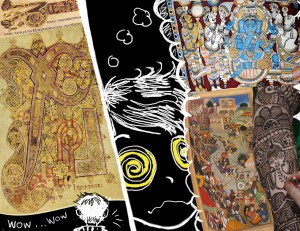Finding the Book of Kells was a magnificent discovery, even though I had no intentions of discussing it for my travel writing blog in the first place. For all I knew, it was only the text within the book that mattered—the handwritten manuscript of the gospels that intrigued me more for its age than its content. Out of sheer whim, I followed two of my classmates to Trinity College where they kept the text behind glass, and I saw for myself what I was missing within the book’s ornate pages. It was not simply the grand composition of the words, but the meticulously colored pictures around them that were awe-inspiring. In fact, I came to realize that the whole book was, in fact, a piece of art—a collage of several Christian symbols visually and symmetrically converged into one. The art style is what historians have come to define as Insular art. To me, it was not the definition that mattered, but what the art style invoked within my mind.
Of course I am not going to start on some clichéd revelation, but I will admit that I got strangely excited when I saw the shapes and patterns enveloping the iconic Christian figures in the text. The artwork was almost hypnotizing. Moreover, it was oddly nostalgic. That was when I realized that my brain was associating the illustrations from the Book of Kells to the oriental paintings I saw when I lived in India. Although Insular art is an abstract form found commonly in ancient texts from the British isles, I could not deny that many of the designs in the Book of Kells resembled the ones found in Indian and Persian art forms. I remember the tapestries that outlined the walls of old forts in India, and how they used to belong to Islamic Mughal lords and Hindu kings, telling stories of great battles, extravagant marriages, and simple court life. Just like in the Book of Kells, the religious ideologies of Hinduism were depicted on several ancient paintings and sculptures in India. But it did not end there.
I think what is really interesting is that these South Asian designs are still recreated today, most commonly in henna art, a type of temporary tattoos for women. In one of the popular pages of the Book of Kells, I noticed that the patterns and hidden drawings of religious figures and animals all told the story of Christ. In the same way, new Indian brides get henna on their arms that intricately depict the age-old customs and rituals of marriage. If such ancient art forms still continue to mesmerize us, then I now know why the Book of Kells is still a source of fascination. It is a shame that it was behind a glass case—I could have used some new ideas for future henna designs.
— Julisa Basak

